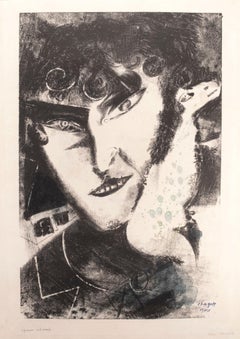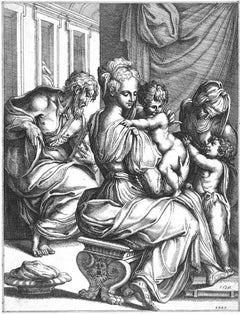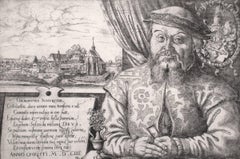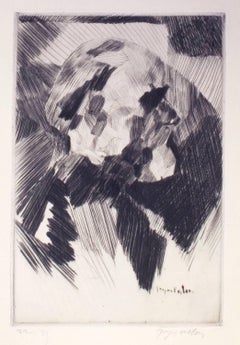R. S. Johnson Fine Art Portrait Prints
to
5
3
2
5
Overall Height
to
Overall Width
to
3
5
4
3
2
2
2
1
1
1
3
2
1
1
1
1
1
1
3
1
1
1
1
Autoportrait avec chèvre (Self Portrait with Goat)
By Marc Chagall
Located in Chicago, IL
Signed Chagall/Marc in blue watercolor (lower right); inscribed in pencil (right margin); inscribed by another hand épreuve rehaussée (left margin)
The authenticity of this work has...
Category
Early 20th Century Portrait Prints
Materials
Watercolor, Lithograph
The Holy Family
By Fra Bonaventura Bisi
Located in Chicago, IL
The Holy Family, 1634
Etching after Parmigianino (Parma 1503 - 1540 Casal Maggiore)
305 x 230 mm.; 12 x 9 inches
References:
Nagler Monogrammisten II...
Category
17th Century Old Masters Portrait Prints
Materials
Etching
Portrait du Prince de Phalsbourg
By Jacques Callot
Located in Chicago, IL
Watermark:
Lion and Star (Lieure 38)
References:
Lieure No. 505
Notes:
An early impression of the only state of this major work.
According to Lieure (Jacques Callot: Catalogue de l...
Category
16th Century Old Masters Portrait Prints
Materials
Etching
Hieronymus Schurstab (1st state)
By Hans Lautensack
Located in Chicago, IL
Etching
195 x 295 mm.; 7 3/4 x 11 3/4 inches
Exhibited:
Old Master Prints & Drawings: 1450 - 1850, R. S. Johnson Fine Art, December 1999: no. 21.
Reference:
Hollstein 68 I/II
No...
Category
16th Century Old Masters Portrait Prints
Materials
Etching
Portrait of E.D.
By Jacques Villon
Located in Chicago, IL
This impression is signed and numbered 24/25. The references for this work are: Auberty & Perussaux 191 and Ginestet & Pouillon E. 277.
This is one of Jacques Villon’s great 1913...
Category
1910s Cubist Portrait Prints
Materials
Drypoint
Related Items
Adam Elsheimer, etching after a painting of Elsheimer by Jan Meyssens
By Wenceslaus Hollar
Located in New York, NY
Wenzel Hollar (1607-1677), Adam Elsheimer, etching after a painting of Elsheimer by Jan Meyssens, 1649, with text and signatures as described below. Ref...
Category
1640s Old Masters Portrait Prints
Materials
Etching
Ancient Roman Statue - Etching by Giovanni Morghen - 18th Century
Located in Roma, IT
Ancient Roman Statue, from the series "Antiquities of Herculaneum", is an original etching on paper realized by Giovanni Morghen in the 18th century.
Signed on plate on the lower le...
Category
18th Century Old Masters Figurative Prints
Materials
Etching
H 19.3 in W 13.39 in D 0.04 in
DUMBO
By Banksy
Located in Aventura, FL
Screen print & hand-finished watercolor on paper. Hand signed and numbered by the artist. Pest Control included.
Banksy’s Dumbo is an extremely rare Ban...
Category
2010s Street Art Figurative Prints
Materials
Screen, Paper, Watercolor
Street in Smyrna
By Marius Bauer
Located in Storrs, CT
Street in Smyrna. 1889. Etching. Wisselingh 34. 7 x 5 1/4 (sheet 12 7/8 x 8 7/8).Edition 100, number 49. A rich, tonal impression printed on Strasbourg cream laid paper on the full s...
Category
Late 19th Century Old Masters Figurative Prints
Materials
Drypoint, Etching
Mu-Tamagawa
Located in Middletown, NY
Woodcut in ink with embossing and hand-coloring in watercolor on laid Japon paper, 16 x 10 inches (406 x 253 mm), ōban tate-e, full margins. Scattered handling wear and toning, other...
Category
Late 19th Century Edo Portrait Prints
Materials
Handmade Paper, Watercolor, Woodcut
The Praying - Etching after Rembrandt - 19th Century
By D'Après Rembrandt
Located in Roma, IT
The Praying is an etching on ivory-colored paper realized by Charles Amand Durand (1831-1905) after an etching by Rembrandt. This wonderful piece of art belongs to a late edition of ...
Category
19th Century Old Masters Figurative Prints
Materials
Etching
Turkish Funeral.
By Marius Bauer
Located in Storrs, CT
A Turkish Funeral. 1889. Etching. Wisselingh 60. 3 3/4 x 5 1/2 (sheet 8 3/4 x 11 7/8). Edition 100, #9. A richly inked impression printed on Strasbourg cream laid paper. Printed on...
Category
Late 19th Century Old Masters Figurative Prints
Materials
Etching
Jeune Femme Cousant; Madame Helleu (Young Woman Sewing, artist's wife)
By Paul César Helleu
Located in Middletown, NY
Paris: Gazette des Beaux Arts, 1892.
Etching and dry point on cream laid paper. 7 9/16 x 5 7/8 inches (191 x 148 mm), full margins. Signed in pencil, lower right margin. A dark, ink...
Category
Late 19th Century Realist Portrait Prints
Materials
Drypoint, Etching
The Spectacle Seller
By Adriaen Jansz van Ostade
Located in Middletown, NY
Etching and drypoint on cream laid paper, 4 x 3 3/8 inches (102 x 86 mm), 1/4 inch margins. Signed in the plate, lower left corner. The 3rd state (of 6), after the rounding of the pl...
Category
Mid-17th Century Old Masters Figurative Prints
Materials
Drypoint, Laid Paper, Etching
Time After Time.
By Ann Chernow
Located in Storrs, CT
Lithograph with watercolor. 22 3/8 x 30 5/8. Edition 56 (plus 5 artist's proofs). A bright impression printed on the full sheet of Arches paper. Signed and numbered 4/56 in pencil.
...
Category
Late 20th Century American Modern Figurative Prints
Materials
Watercolor, Color, Lithograph
Untitled (Portrait)
By William H. Bailey
Located in Fairlawn, OH
Untitled (Portrait)
Drypoint printed in blue-black graphite mixed with silver, 1974
Signed and dated lower ight (see photo)
From: Series entitled Six Drypoints
Edition: 23 (4/23)
Numbered lower left (see photo)
Print Shop: Crown Point Press
Printer: Jeannie Fine
Publisher: Parasol Press, New York
Note: A portfolio is in the collection of the National Gallery, Australia, Fine Arts Museums of San Francisco- de Young/Legion of Honor, Davis Museum at Wellesley College and the Yale University Art Gallery.
Condition: Excellent
Image/Plate size: 6 3/8 x 5 3/8 inches
Sheet size: 24 x 20 inches
From a portfolio of six drypoints, printed with unqiue combination of blue-black graphite shavings combined with silver to create the appearence of an original drawing. I know of no other artist to use a similar printing technique.
William Bailey studied art at the University of Kansas, Yale University and Yale School of Art where he studied with Josef Albers receiving his MFA in 1957.
Mr. Bailey’s first exhibition in New York was at Robert Schoelkopf Gallery in 1968, where he showed regularly until its closing in 1990. During the 90’s he exhibited at the Andre Emmerich Gallery and on its closing, exhibited at the Robert Miller Gallery. In 2004 Bailey moved to the Betty Cuningham Gallery where his most recent exhibition was held from April 30 - June 11, 2016.
Mr. Bailey’s work has been exhibited extensively in both America and Europe. He is represented in the collections of The Whitney Museum of American Art, The Museum of Modern Art, the Pennsylvania Academy of Fine Arts, and the Hirschhorn Museum and Sculpture Garden, among others. He was awarded a Guggenheim Fellowship in painting in 1965. Mr. Bailey was elected to The National Academy of Design in 1983 and to The American Academy of Arts and Letters in 1986.
Mr. Bailey taught at The Yale School of Art from 1958 to 1962 and from 1969 to 1995. He has also taught at The Cooper Union, University of Pennsylvania and Indiana University. He maintains studios in New Haven and in Umbertide, Italy.
Courtesy Betty Cunningham Gallery
Tribute to William Bailey
THE NEW YORK TIMES
William Bailey, whose pristine, idealized still lifes and female nudes made him one of the leading figures in the return of figurative art in the 1980s, died on April 13 at his home in Branford, Conn. He was 89.
His death was confirmed by his daughter, Alix Bailey.
Beyond his painting, Mr. Bailey influenced generations of students in his many years as a teacher at the Yale School of Art.
In some of his best-known work, Mr. Bailey arranged simple objects — the eggs, bowls, bottles and vases that he once called “my repertory company” — along a severe horizontal shelf, or on a plain table, swathing them in a breathless, deceptively serene atmosphere heavy with mystery.
William Bailey, Modernist Figurative Painter, Dies at 89
He swathed his nudes and still lifes of eggs, vases, bottles and bowls in a breathless, deceptively serene atmosphere heavy with mystery.
The painter William Bailey in 2009. He was never given a career survey in a major museum, but his influence, particulary on students at Yale, was deep.
Ford Bailey
By William Grimes for the New York Times
April 18, 2020
William Bailey, whose pristine, idealized still lifes and female nudes made him one of the leading figures in the return of figurative art in the 1980s, died on April 13 at his home in Branford, Conn. He was 89.
His death was confirmed by his daughter, Alix Bailey.
Beyond his painting, Mr. Bailey influenced generations of students in his many years as a teacher at the Yale School of Art.
In some of his best-known work, Mr. Bailey arranged simple objects — the eggs, bowls, bottles and vases that he once called “my repertory company” — along a severe horizontal shelf, or on a plain table, swathing them in a breathless, deceptively serene atmosphere heavy with mystery.
His muted ochres, grays and powdery blues conjured up a still, timeless world inhabited by Platonic forms, recognizable but uncanny, in part because he painted from imagination rather than life.
“They are at once vividly real and objects in dream, and it is the poetry of this double life that elevates all this humble crockery to the realm of pictorial romance,” Hilton Kramer wrote in The New York Times in 1979.
Mr. Bailey’s female figures, some clothed in a simple shift or robe and others partly or entirely nude, are disconcertingly impassive, implacable and unreadable, fleshly presences breathing an otherworldly air.
The critic Mark Stevens, writing in Newsweek in 1982, credited Mr. Bailey with helping to “restore representational art to a position of consequence in modern painting.”
But his version of representation was entirely idiosyncratic, seemingly traditional but in fact “a modernism so contrarian,” the artist Alexi Worth wrote in a catalog essay for the
William Harrison Bailey was born on Nov. 17, 1930, in Council Bluffs, Iowa. His father, Willard, worked in radio advertising and moved the family from city to city in the Midwest. Bill was in his early teens when his father died. His mother, Marjorie (Cheyney) Bailey, was a homemaker who later worked as an accountant for her second husband, Fred...
Category
1970s Realist Portrait Prints
Materials
Drypoint
"Jewish Bride of Fez" from "Costumes of Morocco", Gouache on Paper
Located in Detroit, MI
"Mariée Juive de Fès" translated to "Jewish Bride of Fez" is plate number 52 in Jean Besancenot's stunning portraits and depictions of the people of Morocco from his series "Costumes du Maroc" ("Costumes of Morocco). The woman depicted here is a young Jewish woman dressed for her wedding. She is dressed in traditional fashion for a Jewish wedding for the community in Morocco, a community with a long history in the region, especially the city of Fez, the second largest city in Morocco and known as the "Mecca of the West" for its contributions to religion and learning. For this reason and its northern proximity, Fez was a prominent destination for Jews fleeing Spain. Jewish history in Morocco is long, dating back to the 1st century, their numbers later increased by the Sephardic Jews who were expelled from Spain in 1492 by the Alhambra Decree.
Jean Besancenot's sixty plate reproduced and handcolored gouache on paper study on the diversity of Morocco's cultures is a work of stunning historical importance in tracing the rich and vibrant diversity of North Africa. Besancenot spent the 1930s traveling around Morocco, undertaking an awe-inspiring study of its peoples and rendered in vivid and precise detail the way they traditionally lived and dressed. Many of those outfits and cultural expressions are gone now, with Besancenot's watercolored drawings of them some of the only ways that people can now visit the past. The original manuscript of "Costumes du Maroc" is kept in the Royal Collection in Rabat, with only 310 copies of it produced. These prints are fresh from the folio and have been newly museum framed under conservator glass; unframed the image of the print is 12.75 x 7.75 inches. The tissue guards that bear the caption of the plate have been framed in the verso with the title visible behind clear plastic.
Jean Besancenot, real name Jean Girard, was a photographer, painter, designer, and ethnologist who was born in 1902 in Estrées-Saint-Denis. His work straddles the crossroads of art and ethnography as he was primarily interested in the costumes and ornaments of Morocco in the first half of the 20th century. He arrived for the first time in Morocco in 1934, a country he traveled through until 1939. There he produced a very rich ethnographic documentation on the traditional costumes and adornments of the different Moroccan ethnic groups. His work, composed of photographs, films, drawings and paintings, testifies to the aestheticism of Moroccan cultural heritage that was still marked by little Western influence.
His book "Costumes du Maroc" was published in 1942 at the end of his first trip and presents 60 documented plates of Moroccan costumes...
Category
1940s Portrait Prints
Materials
Gouache, Paper




